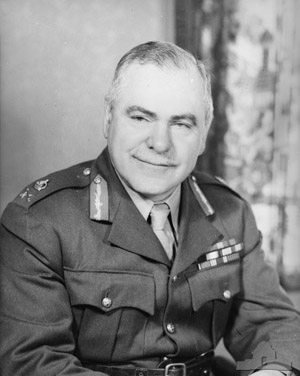![]() The Pacific War Online Encyclopedia
The Pacific War Online Encyclopedia
|
| Previous: Blake, David V.J. | Table of Contents | Next: Blandy, William H.G. |

Australian War
Memorial. Via Wikipedia
Commons
Thomas Blamey was born at Wagga Wagga in New South
Wales. He was the son of a storekeeper and worked as a teacher before
becoming an officer in
the Australian
militia in 1906 via competitive
examination. He attended the staff
college at Quetta, Pakistan in 1911-1913. During the First
World War, he proved himself a capable staff officer in Egypt and at
Gallipoli and rose the
rank of
colonel. After the war, he retired from the Regular Army to become the
chief
commissioner of police in Victoria and commander of 3 Division,
a militia formation. He was fired
from the police in 1936 following charges of corruption.
Recalled to duty when the European war broke out,
Blamey was appointed commander of 2
Australian Imperial Force in 1940. The appointment was made
on the basis
of his administrative skill, but was controversial because of his lack
of
combat experience. It did not help that he was known as
“Typhoid Tom”
because of his tactless, rude, and self-aggrandizing
behavior. Hastings (2007) describes him as "a conceited, corpulent,
devious autocrat." He was briefly second-in-command in the Middle East
under Wavell and
helped organize the evacuation of Crete, but was accused of cowardice
by his own chief of staff ("a coward and not a commander") and of favoritism for arranging the air
evacuation of his son, a staff officer. Tedder, the air commander in
the theater, described Blamey as "a rather unpleasant political soldier
... a tubby little man with a snub nose and expensive complexion, high
blood pressure and a scrubby little white moustache. He has a certain
amount of common sense and 20 years ago may have been fairly useful,
but–!" Auchinleck
and Brooke were also skeptical of
his ability. He disgusted fellow officers with his appetite for alcohol
and women even at the front.
With the outbreak of war in the Pacific, Blamey was recalled to Australia along with two of his divisions, arriving to take command of all Australian land forces in the Pacific on 27 March 1942. He directed the successful defense of Port Moresby and the counterattack along the Kokoda Trail. He was subsequently given command of all land forces in the southwest Pacific under MacArthur. He served in both positions through the remainder of the war.
MacArthur and Blamey came to cordially hated each other, and MacArthur worked with considerably success to marginalize Blamey. For example, MacArthur regularly assigned U.S. combat formations to “task forces,” which were sometimes the size of corps or entire armies, so that they would not fall under Blamey’s command. MacArthur’s attitude may have stemmed in part from the fact that Blamey, like virtually all Australian officers, was a civilian between the world wars. Blamey, in turn, was unimpressed by the MacArthur mystique.
Blamey's willingness to incur casualties by engaging in pointless offensive operations against isolated Japanese formations earned him the emnity of many of his countrymen. He became so unpopular that a demonstration was held against him in Sydney, and the official Australian war historian wrote that "On his head descended perhaps the strongest vituperation to which any military leader in that war was subjected by people on his own side." Blamey tried to justify the operations with the argument that Australia had a duty to liberate its own territory, and that clearing the Japanese from these areas would free the Australian troops for demobilization or participation in the invasion of Japan. In spite of this widespread hostility, Blamey became the only Australian officer to reach the rank of field marshal, in 1950.
| 1884-1-24
|
Born at Wagga-Wagga, New South
Wales |
|
| 1899 |
Schoolteacher |
|
| 1906 |
Commissioned in Australian Army |
|
| 1910 |
Captain
|
|
| 1911 |
Staff College, Quetta |
|
| 1914-7 |
Major |
|
| 1914-12 |
1 Australian Division, Egypt |
|
| 1915 |
2 Australian Division, France |
|
| 1918-5 |
Brigadier
|
|
| 1925 |
Retires from Regular Army to
become commissioner of police, Victoria |
|
| 1931 |
Major general (Citizen Forces) |
Commander, 3 Australian Division |
| 1937 |
Retires from 3 Australian
Division and as commissioner of police |
|
| 1939-9 |
Lieutenant general |
Recalled and given command of 2 Australian Imperial
Force |
| 1942-3-28 |
Commander, Australian Land
Forces, Pacific |
|
| 1942-4-18
|
Commander, Allied Land Forces,
Southwest
Pacific |
|
| 1945 |
Retires |
|
| 1950 |
Field marshal |
Recalled briefly to active duty |
| 1951-5-27 |
Dies at Melbourne |
References
The Pacific War Online Encyclopedia © 2007-2008, 2010 by Kent G. Budge. Index